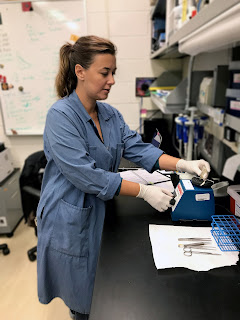USU Study: If you have COVID-19, it’s rare you won’t have symptoms
By Sarah Marshall
Trina Bailey* was not in a rush to get her COVID-19 vaccination. The healthy 27-year-old was a little hesitant since the vaccines were issued under the Food and Drug Administration's Emergency Use Authorization, and not fully approved. Bailey felt she would take her chances in the meantime, since she had no underlying medical issues. Besides, she had read reports stating that many people get COVID and never know it; they never have symptoms, so how bad could it be? However, it wasn't too long before Bailey started experiencing body aches, fever, sinus pressure and coughing, and was diagnosed with COVID.
The reports Bailey refers to may be in error, according to a new study by researchers at the Uniformed Services University of the Health Sciences (USU). The team suggest that COVID infection without symptoms in generally healthy unvaccinated adults is significantly less common than previously reported. The study, “Prospective assessment of symptoms to evaluate asymptomatic SARS-CoV-2 infections in a cohort of healthcare workers,” was published Feb. 14 in Open Forum Infectious Diseases.
The study team established a baseline for each participant, and had participants self-report every day they had any symptoms using a questionnaire that measured severity, frequency, and duration of 34 different symptoms in different areas: nasal, throat, eye, chest, gastrointestinal, body/systemic, and sense (taste/smell).
Participants were PCR tested whenever they had symptoms and routinely had antibody testing conducted monthly to capture any asymptomatic cases or cases that were missed by PCR testing. The researchers found that 12 of the participants tested positive for SARS-CoV-2 infection and that all 12 had disease symptoms, suggesting that completely asymptomatic infection is likely rare.
“We suspect that we observed a higher rate of symptomatic infection than what has been reported by most other studies because of attentiveness to symptoms by study participants as well as the prospective design of our study in which symptoms were collected throughout the fall and winter season every day a person felt they had any symptoms different from their baseline health,” according to the study’s lead author Dr. Emilie Goguet, a Henry M. Jackson Foundation for the Advancement of Military Medicine postdoctoral fellow in USU’s Department of Microbiology and Immunology.
“Some studies suggest that asymptomatic infection may occur as often as 50 percent of the time. However, if this were true, then it would be very unlikely for us to have observed all 12 infected individuals experiencing symptoms,” according to Dr. Edward Mitre, a professor in USU’s Department of Microbiology and Immunology and the senior author of the study. “If we compare this to flipping a coin, the likelihood that one flips tails 12 times in a row is only 0.024 percent. Even if the true rate of asymptomatic infection is 30 percent, then the likelihood that 12 of 12 individuals would all be symptomatic is still only 1.4 percent. It is important to highlight that this study was conducted on an unvaccinated population and may not reflect rates of asymptomatic infection in vaccinated individuals.”
 |
| III Corps soldiers are tested for COVID-19 on Fort Hood, Texas, in February 2021. (U.S. Army photo by Pfc. Kyler Hembree) |
These results demonstrate that individuals cannot reliably differentiate SARS-CoV-2 from other respiratory tract infections based on symptoms alone. The study also compared symptoms that developed in the 12 individuals diagnosed with COVID-19 with those of 38 participants that developed non-COVID-19 respiratory illnesses, Mitre added. Runny nose, sinus pressure, and sore throat occurred in more than 70 percent of infected participants and in more than 70 percent of symptomatic SARS-CoV-2 negative individuals. Loss of smell or taste, which were the most distinctive symptoms in patients with COVID-19, also did not occur with sufficient frequency or specificity to differentiate SARS-CoV-2 from non-COVID-19 illnesses.
Trina Bailey had the insight to get herself tested for COVID-19 when she started experiencing symptoms, and quickly recovered after her positive diagnosis. With the findings of this new study, hopefully more people experiencing symptoms will take the initiative to get themselves tested as soon as possible.
*Editors Note: Not individual’s real name.






